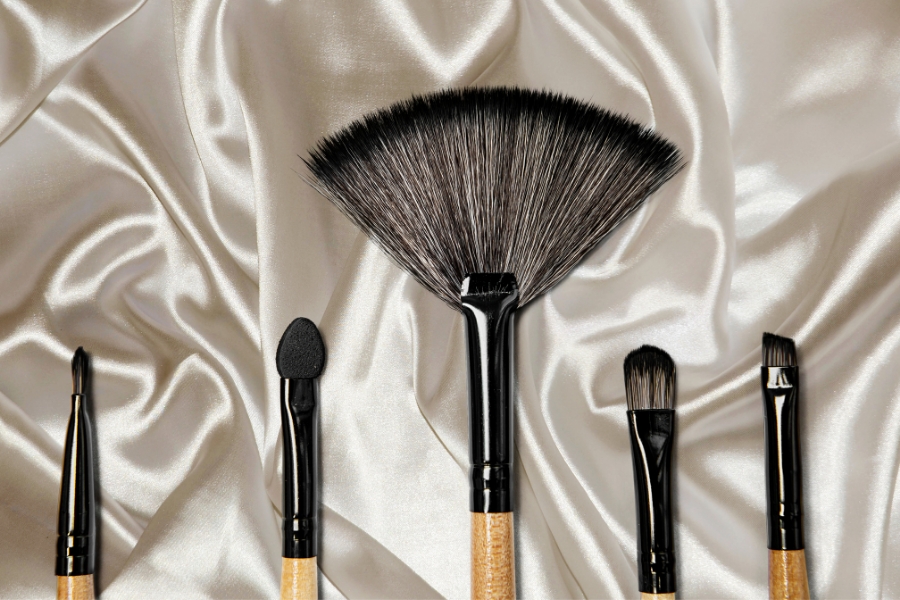The Brush Up: Importance of Cleaning Makeup Brushes & Facial Cleansing Tools
Written by Mary Nielsen
During consultations with clients who are struggling with persistent acne breakouts, an easy but pertinent question to ask is, “When was the last time you cleaned your makeup brushes?”
Clients use makeup brushes to apply concealer and foundation every day. Bacteria build up in the bristles of these brushes and can increase the frequency of acneic breakouts, spreading, and re-spreading infection. Skin irritation, dermatitis, clogged pores, and even viral and bacterial infections, like staph, strep, and E. colican arise from the use of dirty makeup brushes. Additionally, dirty eyeliner brushes and eyelash curlers can cause conjunctivitis.
If the “ick” factor of bacteria alone is not enough to motivate clients to clean their makeup brushes, inform them that they are increasing oxidative stress and the formation of free radicals, which could increase premature aging of the skin.
Since most clients do not clean their makeup brushes and other makeup tools properly or as often as they should discuss how to clean them, so you can educate clients.
TIMING & CLEANING
Firstly, how often should makeup brushes be cleaned? Most celebrity makeup artists believemakeup tools should be cleaned weekly at least.
In addition to improving the health of the skin, cleaning will also extend the life of brushes Clean brushes will allow better product application because brush hair bristles are porous and attract dead skin cells, bacteria, debris, and oil from the skin, which makes blending products more difficult.
Cleaning brushes is probably easier than clients think and does not necessarily require a special brand of brush cleaner. A gentle facial cleanser will work to remove the debris and keep the bristles soft and pliable. Wet the brush bristles with warm water and place a drop of cleanser in your non-dominant palm. Using your dominant hand, swirl the bristles in the cleanser, letting warm water run through your hand while manipulating the brush, ensuring all bristles are affected. Take care not to let the force of the water run directly into the bristles toward the handle. This can loosen the glue holding the brush bristles in place. Rinse the brush completely. Squeeze the excess moisture out with a towel and shape the bristles in place. Finally, set the brush to dry with the bristles hanging free over the edge of a counter or top of a wide container.
Cleaning gloves or cleaning mats for brushes are also options. They are typically made of silicone, relatively inexpensive, and have varied surfaces that work well to get the grime out of bristles. Be sure not to mash the brush into the surface. A gentle swirling motion is enough.
Eyelash extensions have decreased the popularity of eyelash curlers, but some people still use them as an essential part of their makeup routine. Eyelash curlers can harbor the same kinds of bacteria, dead skin cells, and infectious material found in makeup brushes.
To clean aneyelash curler, use a cotton ball or cotton round with makeup remover or a low- comedogenic oil like jojoba oil. Apply light friction to the rubber or silicone strip on the eyelash curler to loosen and eventually remove the dried debris. Rinse well under running water. Dry thoroughly to prevent rust from forming, using a blow dryer if necessary. Including eyelash curlers in your weekly practice of brush cleaning will ensure eye health and extend the life of the curler.
CLEANSING DEVICES
Facial cleansing devices, especially brush-style ones, work well to provide cleansing and exfoliation but can also be breeding grounds for bacteria. These tools require special sanitation. In addition to cleaning with an antibacterial soap every few days, soaking the head in alcohol for one minute and then air-drying is recommended on a weekly basis. Replace the brush head every three months to keep skin healthy.
To ensure makeup brushes, eyelash curlers, and facial cleansing devices are completely clean, consider a final step of sterilizing in a UV-C light. Ultraviolet radiation has been used since the late 1800s for killing bacteria on non-porous surfaces, as well as in the air and water. The FDA considers these UV-C lights germicidal and effective against COVID-19 and SARS-CoV-2. Applying UV-C light to makeup tools for 30 minutes with a distance ofno more than eight feet has been shown to be effective. Educating clients on the importance of cleaning makeup brushes and facial tools, as well as committing to your own regular sanitation schedule, will give clients healthier skin and prevent the spread of infection.

Technician, educator, mentor, and business owner, Mary Nielsen has been at the forefront in medical aesthetics since its infancy in the early 1990s. She is an Oregon-certified advanced aesthetician and a licensed aesthetics instructor. She serves as vice chair of the Oregon Board of Certified Advanced Estheticians. She is the author of several aesthetics books, including four chapters in the latest “Milady’s Esthetics” textbook.
